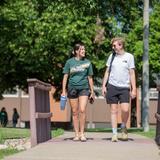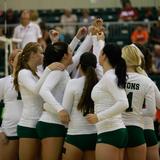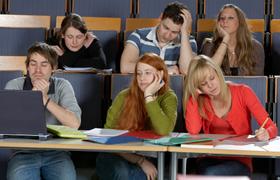- The College achieves its mission by providing specialized technical programs in agriculture, environmental/natural resource studies, and business as well as through traditional curriculum that transfer to baccalaureate programs. The opportunities for experiential learning in attractive outdoor settings allow the unique educational programs on this campus to be intensified. A commitment to "hands-on" learning and the use of natural resource laboratories are common instructional techniques. The proximity of the campus to the International Peace Garden, J. Clark Salyer National Refuge, Denbigh Experimental Forest, the Turtle Mountains, and the offices of the North Dakota Forest Service provides a natural setting to support unique training programs serving all constituents.
School Highlights
Dakota College at Bottineau serves 1,378 students (24% of students are full-time).
The college's student:teacher ratio of 14:1 is same as the state community college average of 14:1.
Minority enrollment is 28% of the student body (majority Hispanic and Black), which is less than the state average of 34%.
Quick Stats (2025)
- Enrollment: 1,378 students
- In-state tuition: $5,046
- Out-state tuition: $7,161
- Student:teacher ratio: 14:1
- Minority enrollment: 28%
- Source: Verified school update
School Overview
The teacher population of 99 teachers has stayed relatively flat over five years.
Dakota College at Bottineau
(ND) Community College Avg.
Carnegie Classification
Associate's Colleges: High Career & Technical-High Nontraditional
Baccalaureate/Associate's Colleges: Mixed Baccalaureate/Associate's
Institution Level
At least 2 but less than 4 years
At least 2 but less than 4 years
Institution Control
Public
Public
Total Faculty
99 staff
99 staff

School Calendar
Student Body
The student population of Dakota College at Bottineau has grown by 36% over five years.
The student:teacher ratio of 14:1 has increased from 11:1 over five years.
The Dakota College at Bottineau diversity score of 0.47 is less than the state average of 0.54. The school's diversity has declined by 7% over five years.
Total Enrollment
1,378 students
718 students

Student : Teacher Ratio
14:1
14:1

# Full-Time Students
330 students
330 students

# Part-Time Students
1,048 students
751 students



# Enrollment Undergraduate
137 students
248 students
# Full-Time Undergraduate Students
330 students
330 students

# Full-Time Graduate Students
n/a
12 students
# Part-Time Undergraduate Students
1,048 students
751 students
# Part-Time Graduate Students
n/a
10 students
Total Dormitory Capacity
259 students
259 students

% American Indian/Alaskan
3%
1%

% Asian
1%
1%

% Hispanic
5%
4%

% Black
3%
4%

% White
72%
66%

% Hawaiian
5%
4%

% Two or more races
4%
4%

% Non Resident races
5%
2%

% Unknown races
3%
14%


Diversity Score
0.47
0.54

College Completion Rate (Students who graduate in less than 4 years)
0.3288%
0.4495%

College Completion Rate (Students who graduate in 4 years or more than 4 years)
n/a
0.55%
Average Graduate Earnings (10 Years)
$36,700
$38,300

Tuition and Acceptance Rate
The public in-state tuition of $5,046 is more than the state average of $4,431. The in-state tuition has stayed relatively flat over four years.
The public out-state tuition of $7,161 is more than the state average of $7,084. The out-state tuition has stayed relatively flat over four years.
In-State Tuition Fees
$5,046
$4,431

Out-State Tuition Fees
$7,161
$7,084

Tuition Notes
There are various out-of-state tuition rates based upon residency. Please visit www.dakotacollege.edu to learn more.
% Students Receiving Some Financial Aid
88%
94%

Median Debt for Graduates
$10,754
$10,754

Median Debt for Dropouts
$5,500
$5,500

Acceptance Rate
n/a
92%
SAT Reading
n/a
520
SAT Math
n/a
545
SAT Writing
n/a
470
ACT Composite
n/a
19
ACT English
n/a
18
ACT Math
n/a
20
ACT Writing
n/a
7
Sports
Total Sports Offered
5 sports
Sports
Baseball, Basketball, Ice Hockey, Softball, Volleyball
Extracurriculars
Total ExtracurricularsTotal Extra-curric.
10 extracurriculars
ExtracurricularsExtra-curric.
Club or Organization:
CRU, Honors Program, Horticulture Club, Leaderjacks, LumberActs (Drama), Phi Theta Kappa Honor Society, Student Senate, Study Abroad, Wildlife Club
Recreational Athletic Programs:
Intramural Sports
CRU, Honors Program, Horticulture Club, Leaderjacks, LumberActs (Drama), Phi Theta Kappa Honor Society, Student Senate, Study Abroad, Wildlife Club
Recreational Athletic Programs:
Intramural Sports
Source: 2024 (or latest year available) Integrated Postsecondary Education Data System (IPEDS) , School Administrators
School Notes
- Dakota College at Bottineau is accredited by the Higher Learning Commission (HLC). The HLC is one of six regional institutional accreditors in the United States. The Higher Learning Commission accredits degree-granting post-secondary educational institutions in the North Central region, which includes North Dakota. DCB has been accredited since 1971. It received a reaffirmation of accreditation in 2009-2010 and is scheduled for its next reaffirmation in 2019-2020.
Frequently Asked Questions
How much does Dakota College at Bottineau cost?
Dakota College at Bottineau's tuition is approximately $5,046 for In-State students and $7,161 for Out-State students.
What schools are Dakota College at Bottineau often compared to?
Dakota College at Bottineauis often viewed alongside schools like Bismarck State College by visitors of our site.
What sports does Dakota College at Bottineau offer?
Dakota College at Bottineau offers 5 interscholastic sports: Baseball, Basketball, Ice Hockey, Softball and Volleyball.
Recent Articles

Obtaining Your Bachelor's Degree at a Community College
Explore the evolving landscape of community colleges offering bachelor's degrees, addressing affordability, accessibility, and workforce needs.

A to Z of Community College Certificates and Courses
From business and healthcare to technology and skilled trades, the article showcases the breadth of options available to students seeking to enhance their knowledge, develop new skills, or pursue career advancement.

What is a Community College?
This comprehensive guide explains what a community college is, its history, and its role in higher education. It covers the types of programs offered, differences from four-year colleges, benefits of attending, and important considerations for prospective students, providing valuable insights for those exploring educational options.















